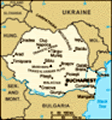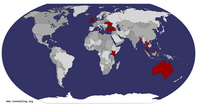COMING SOON HOUSE ADVERTISING ads_leader
Transylvania (derived from the Latin “land beyond the forest”) is true to its name, for this region stretches across undulating hills decorated by a thick carpet of forest, and it is superior in scale to every other European forest I have seen. In fact, these forests contain the largest bear population in Europe, and notices alerting people of their presence are found on road signs and elsewhere.
One can drive along winding roads heavily bordered by overhanging trees and peer into a seemingly disorganised array of tree trunks where the sunlight barely penetrates the thick foliage. Occasionally the forest would clear to reveal a village or town nestled snugly against the trees, hills and mountains. Romania is rich with castles and churches, and within these clearings lie some of the finest buildings you could hope to visit. But for most people, these castles and churches are largely unknown – with the exception of one.
With my guide and driver Valentin leading the way, we drove to the most famous of these buildings. Bran Castle is also erroneously known as Dracula’s Castle due to a very tenuous and brief relationship with Vlad the Imapler. Ascending the steep cobblestone road shadowed
by lush trees on a cool day, Valentin and I climbed an even steeper stone stairway to enter whitewashed rooms decorated with period furnishings. It was easy to understand Bran Castle’s claim as Romania’s most popular attraction as swarms of tourists congested the narrow stairs and doorways. However, Bran Castle failed to impress me; it felt too sanitised, and I had no connection with the place at all.
Perhaps my opinion was tainted by the first bout of illness during my 18 months on the road. A sore throat of the previous two days became a slight fever just after departing Bran Castle that abated by the next morning. Thankfully, my illness was assuaged by staying in my favourite Romanian city. Brasov has strong German roots as indicated by its alternate name of Kronstadt (“Crown City”). The beautiful streets held endless rows of ornate architecture coloured in pastel hues. On Sunday morning Valentin and I wandered through the city, choosing any street or alley that took our fancy. Church bells echoed through the empty streets with the only activity confined to elderly couples emerging from their homes suitably attired for a religious service.
Though I was disappointed in
Bran Castle, there are far superior and lesser known castles to admire in Romania, including one that could be termed a palace. Peleş Castle rests not far from the town of Sinaia and is arguable the jewel of Eastern European castles. This site was chosen for its location amongst a glorious mountain backdrop as a summer residence for King Charles I. Though it opened in 1875, it was one of the first buildings in Europe to be equipped with central heating, an elevator and even an internal vacuum system – all of which still are in working to this day. Such was the advanced nature of Romania prior to arrival of war and communism in the middle of the twentieth century.
Touring Peleş requires one to join a group with a guide and on this late afternoon, Valentin and I took the tour of the ground floor’s public rooms. The castle is a opulent array of eclectic styles and every room adopted its chosen theme, whether Turkish, Moor, or Italian, to exquisite excess. Peleş is Valentin’s favourite site in Romania, and it was easy to understand why.
That evening I mused on my decision not to purchase a
camera pass nor take the tour of the first floor, so the next day we returned for the first full tour of the morning, but this time with camera pass in hand. Though our group numbered a dozen for the first part of the tour, only four proceeded to the first level, so it was a more intimate experience, perfectly suited to observing the private rooms of the royalty who once resided here. Plush theatres, wooden panelled reception rooms and richly decorated bed chambers were revealed at every turn. I was particularly pleased for Valentin as it was the first time he had toured that floor for the vast majority of tour groups have insufficient time in their schedule to tour the castle more extensively.
Sinaia held another site that introduced another prevalent attraction of Romania, the considerable churches of different denominations. Often these churches would be the tallest building in any village, and their distinctive domes, spires or bell towers easily sighted from any vantage. The Old Church in Sinaia Monastery was the typically small design for an Orthodox church, and the city name of Sinaia was derived from this Monastery, which in turn sourced its name from
St Catherine’s Monastery on Mt Sinai in Egypt. Built in 1695, the ceilings of the church contain the incredible art of Pârvu Mutul, and I admired the beautiful paintings of apostles, saints and angles until I my admiration was interrupted by the closure of the church in the late afternoon.
My highlight in Romania was a last minute schedule suggestion by Valentin to visit a fortified church in Viscri. Built in the 13
th century and during an era when raids from marauders were common, these churches were built within fortified walls, and when an attack was imminent, villagers would flock to there for both prayer and protection. This church lies far off the main road in the midst of a gypsy area, easily identified by their darker complexion and iconic gypsy caravans.
Generally, gypsies the world over are viewed as outsiders and treated at best with indifference or at worst with suspicion and even hatred. Romanians are proud of their Latin heritage, a heritage different from the neighbouring countries – and certainly very different from the gypsies. There are strong Italian influences to be found, and to evidence this point, a statue of Romulus and Remus (mythological founders
of Rome) with a she-wolf sits in every major city.
The impression of Romania from parts of Europe appears to be swayed by the gypsy presence, as people attribute the perceived qualities of gypsies to the whole nation, when in fact Romanians themselves view gypsies with the same degree of indifference as other Europeans. Thus one should identify Romania more with its Latin roots than gypsy influences.
The Viscri Fortified Church was visited after driving along a heavily cobbled street and walking along an equally rough path. Sitting atop a hillside, the white walls and terracotta roof of the complex looked particularly imposing when viewed from lower down the declivity. Once inside this quiet and infrequently visited UNESCO World Heritage site, I removed my hat and strode into the simple church. It was apparent that any restoration work had not unduly modernised this underappreciated gem, for the interior still held worn wooden benches that served as pews and walking anywhere in the upper level required a degree of dexterity to navigate the narrow stairs and uneven floors cramped with more benches.
Climbing into the tower, I had to ascend a collection of rickety wooden staircases that unnervingly

 Peleşor Castle - Sinaia, Romania
Peleşor Castle - Sinaia, Romania
This was constructed as a more intimate retreat near to Peleş Castle.shook if one trod too heavily. Finally at the top, it allowed me to gaze at Viscri from the highest point in the village, and with almost no sense of modernity such as telephone or electricity wires viewed from this vantage, it indeed did feel like that this slightly precarious ascent has transported me back centuries. Though rough and rustic, this site had immense charm and it should be on every Romanian itinerary.
That evening, Valentin and I strolled through the old city of Sighișoara, and I wondered if anything could surpass the Viscri Fortified Church as my favourite religious site in Romania. However, it was almost usurped after leaving Transylvania a few days later by the incredible Cathedral of Curtea de Argeș. Constructed approximately 400 years ago, its interior is an astonishing collection of gold panels and icons usually found in Orthodox churches, and the vivid, rich paintings that clung to almost the entirety of its vaulted interior were extraordinary. Valentin and I spent much time here, waiting for the tour groups to quickly come and go (as they usually do) so as to enjoy and photograph in relative silence and solitude this sumptuous interior.
The Cathedral
of Curtea de Argeș has a strong historical importance for the kings and queens of Romania are interred within the building or the surrounding gardens. In one darkened corner lies the much revered King Ferdinand I who enlarged Romanian territory through treaties following the conclusion of the First World War. A fresh lily sat in a porcelain vase at the head of the tombstone, and it illuminated this corner of the cathedral much like the deeds of Ferdinand illuminates Romanian history.
Romania has endured centuries of conflict and subversion, yet they simultaneously built some incredibly fine castles and churches that have left a worthy legacy. These largely unknown architectural gems that lay within lush forests, isolated villages and medieval towns ensure that Romania is a country meriting extensive exploration.
My visit to Romania was kindly supported by flydubai. All views are my own.
COMING SOON HOUSE ADVERTISING ads_leader_blog_bottom
Tot: 0.1s; Tpl: 0.016s; cc: 13; qc: 38; dbt: 0.0428s; 1; m:domysql w:travelblog (10.17.0.13); sld: 1;
; mem: 1.2mb




































taracloud
Tara Cloud
"exquisite excess" indeed
What fabulous architectural gems and lush countryside! Such incredible detailing in the palaces and churches, it's no wonder you lingered in them. Really delicious photos--well done.